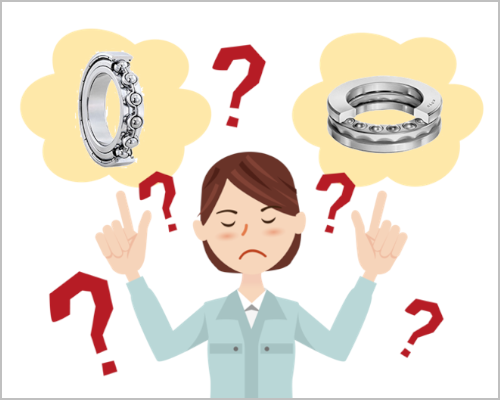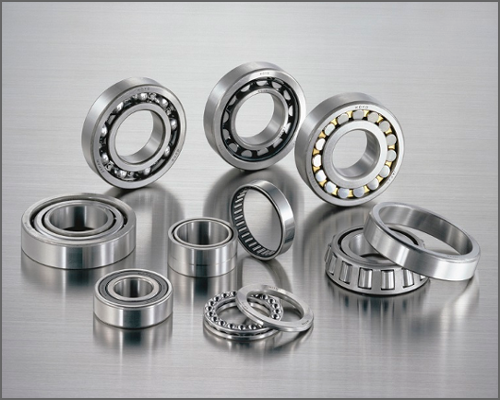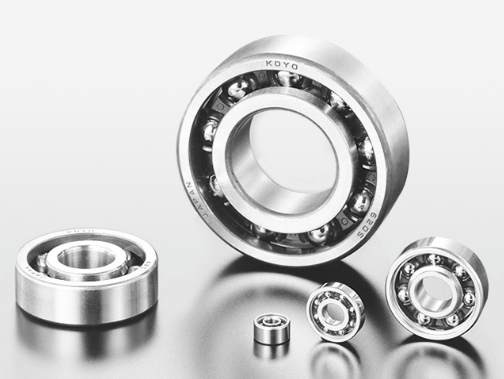Bearing Trivia
How to Select the Right Bearing (Part 6): Bearing lubrication
- #2 How to Select the Right Bearing
In Part 5, we explained about the preload and rigidity of a bearing.
A list of earlier "How to Select the Right Bearing" entries can be seen here.
In Part 6, we will explain about bearing lubrication as a measure for whether the bearing type you chose was appropriate.
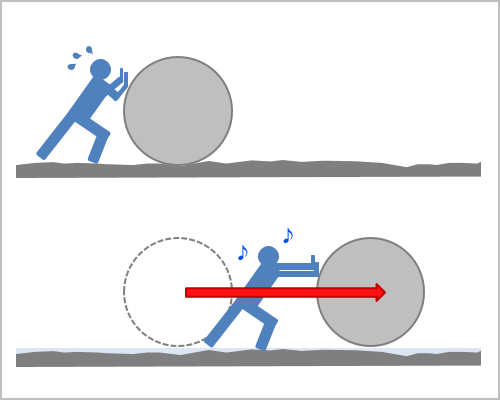
The surfaces of bearing rolling elements and rings (inner ring and outer ring) are finished extremely smooth. But however smooth they are their surfaces still have unevenness.
When a bearing rotates, the convex regions of the bearing rings and the rolling elements come in contact with each other. This contact between the convex regions leads to friction and wear, inhibiting the smooth rotation of the bearing. (See Figure 1.)
 Fig. 1: Contact between a bearing ring and a rolling element (with no lubricant)
Fig. 1: Contact between a bearing ring and a rolling element (with no lubricant)
In order to prevent this friction and wear, oil or some other substance is applied between the contact regions. This is called "lubrication." With the appropriate lubrication, an oil film makes it so that the rolling elements and bearing rings do not come in direct contact. This results in less friction and a massive decrease in wear. (See Figure 2.)
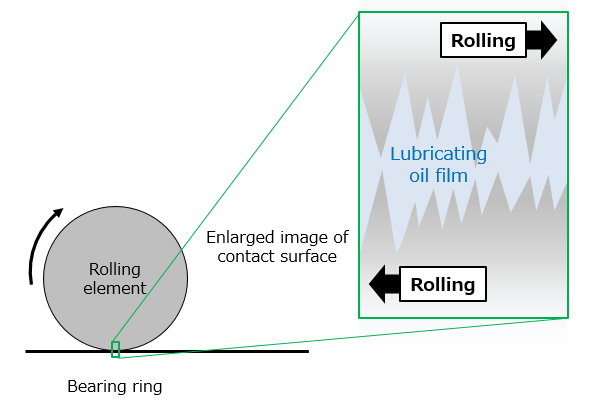 Fig. 2: No contact between a bearing ring and a rolling element (with lubrication)
Fig. 2: No contact between a bearing ring and a rolling element (with lubrication)
For stable and soomth rotation of the bearing, it is necessary to redeuce the friction caused by the rolling motion and prevent the wear of the bearing components. "Lubrication" plays a major role in this process.
Table 1: Bearing selection checklist
| Order | Examination item | Major points to confirm |
|---|---|---|
| ① | Bearing type | What magnitude and direction of load do you need? Will it fit in the installation space? |
| ② | Bearing arrangement | Are you using two (or more) bearings on a single shaft? |
| ③ | Bearing dimensions and service life | Do the dimensions and service life satisfy your needs? |
| ④ | Bearing limiting speed, running accuracy, fits and internal clearance | Does it have the necessary running accuracy and rigidity for the machine? Does it have the fits and internal clearance to satisfy its service life? |
| ⑤ | Bearing preload and rigidity | Does it have the necessary rigidity for the machine? |
| ⑥ | Bearing lubrication | Can the bearing rotate stably over a long period of time? <This is the focus of Part 6> |
| ⑦ | Components around the bearing | What bearing surrounding structure/assembly are you looking for? |
| ⑧ | Bearing mounting and dismounting | Will it facilitate maintenance/inspection of the machine? |
Below is an explanation of the lubricating methods used to allow the bearing to rotate stably over a long period of time.
- Purpose of lubrication
- Types of lubrication
- Features of grease lubrication
- Features of oil lubrication
1. Purpose of lubrication
The primary purpose of lubrication is to reduce friction and wear, but there are also other reasons for lubrication (see Table 2).
Table 2: Purposes of lubrication
| No. | Purpose |
|---|---|
| 1 | To reduce friction and wear on the components of the bearing |
| 2 | To carry away the heat generated by friction inside the bearing, and decrease the temperature |
| 3 | To prolong the bearing fatigue life by maintaining the proper oil film on the rolling contact surface at all times |
| 4 | To prevent corrosion during use of the bearing |
| 5 | To remove contaminants that penetrate into the inside of the bearing |
This lubrication brings about various positive effects for the bearing.
2. Types of lubrication
The major types of bearing lubrication are: grease lubrication, which uses semi-solid (i.e., like cream) grease; and oil lubrication, which uses lubricating oil.
Because grease is semi-solid, it tends not to leak out and can be easily affixed to the inside of the bearing. Since this makes it convenient as a sealing device, grease lubrication is widely applied for bearings.
On the other hand, oil lubrication is more effective as a lubricant than grease lubrication, and so is used in situations where such factors as high-speed rotation, a large cooling effect, or dirt filtering are required (see Table 3).
Table 3: Comparison between grease and oil lubrication
| No. | Item | Grease lubrication | Oil lubrication |
|---|---|---|---|
| 1 | Sealing device | Simple | Slightly troublesome Care needs to be taken for the maintenance of the device |
| 2 | Lubricating ability | Good | Excellent |
| 3 | Rotation speed | Low/medium speed | Can be used in high-speed rotation |
| 4 | Replacement of lubricant | Slightly troublesome | Easy |
| 5 | Life of lubricant | Relatively short | Long |
| 6 | Cooling effect | No cooling effect | Good (but circulation is needed) |
| 7 | Filtration of dirt (removal of contaminants) |
Difficult | Effective |
Aside from the above grease lubrication and oil lubrication, in bearings used in some special environments other solid lubricants are also in use. For information on these, see the following.
Bearings Made Using Advanced Materials and Lubricants: Bearings all around you
Regarding both grease lubrication and oil lubrication, we will now explain about "lubricants," "how to select a lubricant," and "lubrication method."
3. Grease lubrication
1) What is grease?
The main components of grease are base oil (lubricating oil), thickeners, and additives, and the components and amounts of these are adjusted and blended according to the purpose of use (see Table 4).
Table 4: The components of grease and their roles
| Component | Role | |
|---|---|---|
| Grease | Base oil (lubricating oil) |
Oil with excellent lubricating function |
| Thickener | Disperses in base oil and retains oil to make it semi-solid (determines characteristics such as operating temperature range and mechanical stability) |
|
| Additives | Complements performance according to the purpose of use (e.g.: withstanding heavy loads, preventing rust) |
The lubricating oil used for the base oil is explained in "4. Oil lubrication" further down this column.
The thickener disperses throughout the base oil (lubricating oil) and makes it semi-solid, preventing the base oil from spilling out.
The additives complement the performance needed for the purpose of use.
With grease lubrication, when the bearing rotates the base oil gradually oozes out and lubricates the bearing.
2) How to select the right grease
We should select the appropriate grease with the characteristics needed for the purpose of use (see Table 5).
Table 5: Examples of characteristics of grease
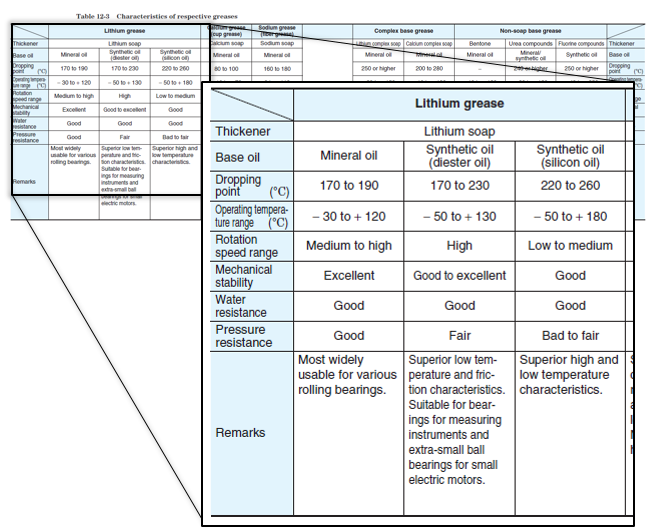
<N.B.>
Greases of different brands should not be mixed.The grease's characteristics may change and cause damage to the bearing.
3) Grease lubrication method
As the primary methods of grease lubrication, allow us now to look at grease-packed bearings (wherein grease is filled inside the bearing in advance ) and the feeding method.
a) Grease-packed bearings
Grease-packed bearings are bearings that are sealed by the bearing manufacturer using a shield or seal after inserting the necessary grease into the inside of the bearing (see Figure 3).
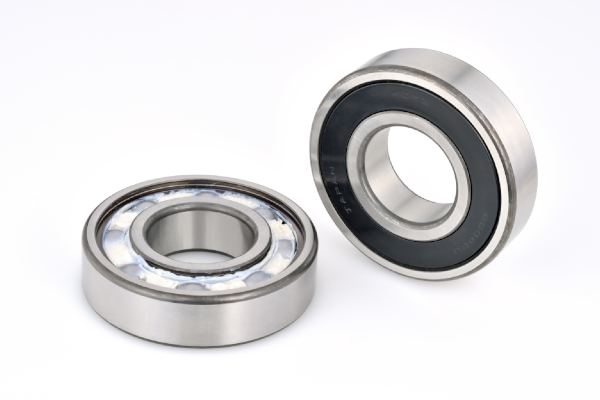 Fig. 3: Grease-packed bearings with seals
Fig. 3: Grease-packed bearings with seals
b) The grease feeding method
After mounting a non-greased bearing ino the machine, grease is filled onto the bearing (see Figure 2). Grease supplied through the grease nipple is filled into the grease sector inside the housing, flowing into the inside of the bearing. Used grease is pumped out of the bearing and ejected out of the housing by the centrifugal force of the rotary disc attached to the grease valve.
 Fig. 4: An example of the grease feeding method
Fig. 4: An example of the grease feeding method
The grease feeding interval can be determined by the type, size, and rotation speed of the bearing.
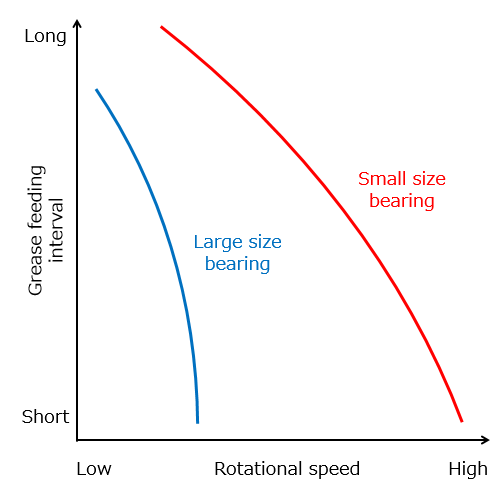 Fig. 5: Grease feeding interval
Fig. 5: Grease feeding interval
Grease feeding interval - Ball & Roller Bearings Catalog
4. Oil lubrication
1) What is lubricating oil?
Generally, mineral oil--which is a refined crude oil and suitable for lubrication--is used as lubricating oil.
However, mineral oil has the disadvantages that it oxidizes at high temperatures and its lubricating function deteriorates, and that at low temperatures its viscosity increases and the force required to stir the lubricating oil (the "stirring resistance") increases.
For this reason, we use synthetic oil that has excellent lubricating function in high temperature or low temperature (see Table 6).
Additives are added to the lubricating oil to improve certain characteristics (preventing oxidation, rust, foam, and so on).
Table 6: Characteristics of the various types of lubricating oil
| Type of lubricating oil | Highly refined mineral oil | Synthetic oil | |
|---|---|---|---|
| Silicon oil | Polyphenyl ether oil | ||
| Operating temperature range (℃) | -40 ~ +220 | -70 ~ +350 | 0 ~ +330 |
| Lubricity | Excellent | Fair | Good |
| Oxidation stability | Good | Fair | Excellent |
| Radiation resistance | Bad | Bad - Fair | Excellent |
2) How to select the right lubricating oil
Select the lubricating oil with the appropriate viscosity for the operating temperature of the bearing. First we select the lubricating oil with the proper kinematic viscosity for the type of bearing (see Table 7).
Table 7: Proper kinematic viscosity by bearing type
| Bearing type | Proper kinematic viscosity at operating temperature(mm2/s) |
|---|---|
| Ball bearing Cylindrical roller bearing |
13 or higher |
| Tapered roller bearing Spherical roller bearing |
20 or higher |
| Spherical thrust roller bearing | 32 or higher |
Next we select the proper kinematic viscosity for the bearing operating condition (see Table 8).
Table 8: Proper kinematic viscosity by bearing operating conditions
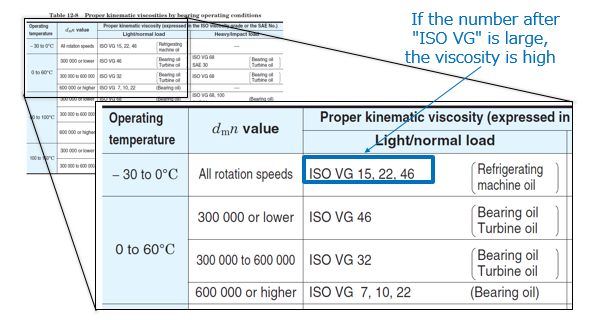
Lubricating oil with low kinematic viscosity is smooth, the lubricating oil having little resistance. It is used in bearings that rotate at high speed. However, if the kinematic viscosity is too low, there will be insufficient formation of the lubricating oil film, and the lubricating effectiveness will be decreased.
On the other hand, lubricating oil with high kinematic viscosity is thick, the lubricating oil film being strong. It is used in bearings to which a heavy load is applied. However, if the kinematic viscosity is too high, the viscosity resistance of the lubricating oil will cause a large amount of heat to be generated.
The kinematic viscosity of lubricating oil changes depending on the temperature (see Figure 6). For this reason, consider the temperature during operation when you select the lubricating oil.
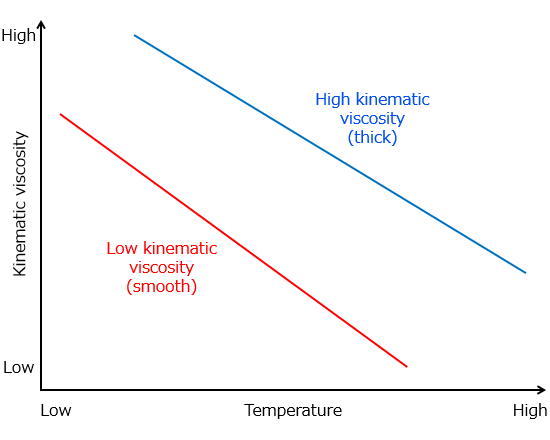 Fig. 6: The relationship between oil viscosity and temperature
Fig. 6: The relationship between oil viscosity and temperature
3) Oil lubrication method
In order to select the most appropriate lubricating method from among the many methods of oil lubrication, consider the operating condition, usage criteria, and cost.
Allow us to explain about the four most common methods of oil lubrication.
a) Oil bath
This is a method of operating the machine by immersing the bearing in lubricating oil. It is suitable for low- to medium-speed rotation.
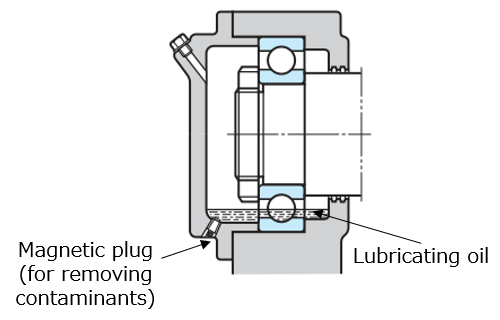 Fig. 7: Oil bath
Fig. 7: Oil bath
b) Oil drip
Lubricating oil is dripped from the oiling device and the effect of the rotating part causes the lubricating oil to mist and fill the housing. This has a cooling effect. This method can be applied at relatively high speeds and mid-level loads.
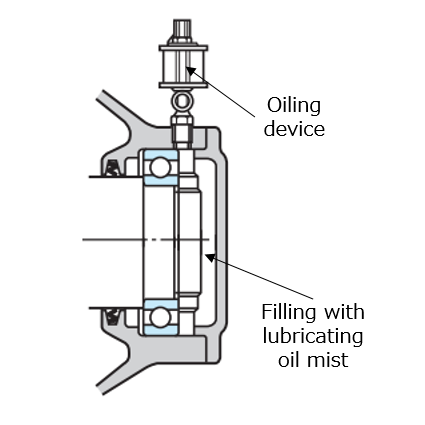 Fig. 8: Oil drip
Fig. 8: Oil drip
c) Oil splash
This is a method in which gears, etc. are attached to the shaft, the lubricating oil is splashed, and it is made into droplets for oil supply. This method can be applied at relatively high speeds.
 Fig. 9: Oil Splash
Fig. 9: Oil Splash
d) Forced oil circulation
This is a lubrication method in which the lubricating oil is inserted inside the bearing, then cooled, and then circulated again. It is most commonly applied in high-speed rotation or high-temperature conditions.
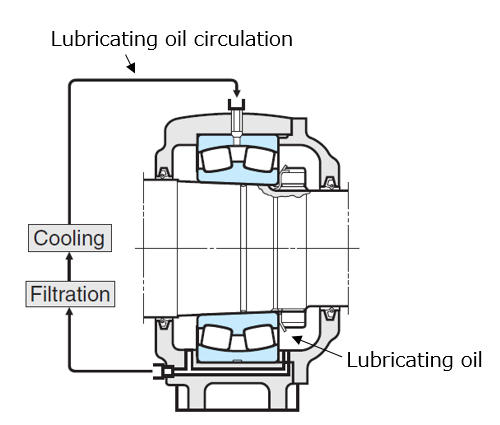 Fig. 10: Forced oil circulation
Fig. 10: Forced oil circulation
There are other methods of oil lubrication, such as oil jet lubrication and oil mist lubrication, so please see the following:
Oil lubrication - Ball & Roller Bearings Catalog
Conclusion
Bearings aim for stable and smooth rotation, and to do that the friction with rolling motion needs to be reduced and the abrasion of the various components needs to be prevented. "Lubrication" plays a major role in this process. It is important to choose the appropriate lubricant and lubricating method in order to allow the bearing to rotate stably over a long period of time.
- The major types of bearing lubrication are: grease lubrication, which uses semi-solid (i.e., like cream) grease; and oil lubrication, which uses lubricating oil.
- Most bearings use grease lubrication, which is convenient as a sealing device.
- For situations where such factors as high-speed rotation, a large cooling effect, or waste filtering are required, oil lubrication is used.
- In order to select the most appropriate lubricant (grease or lubricating oil) and lubricating method, consider the operating condition, usage criteria, and cost.
